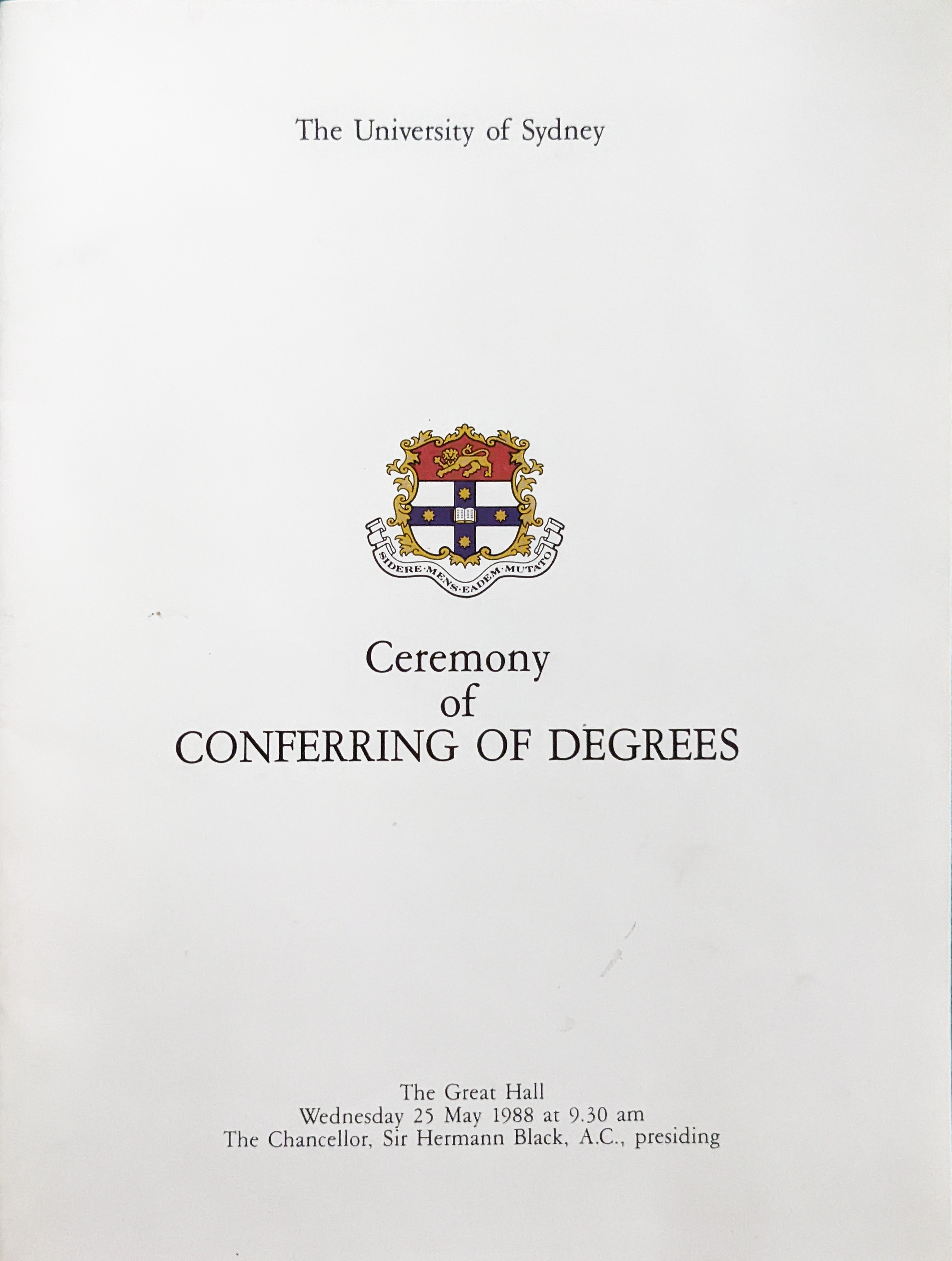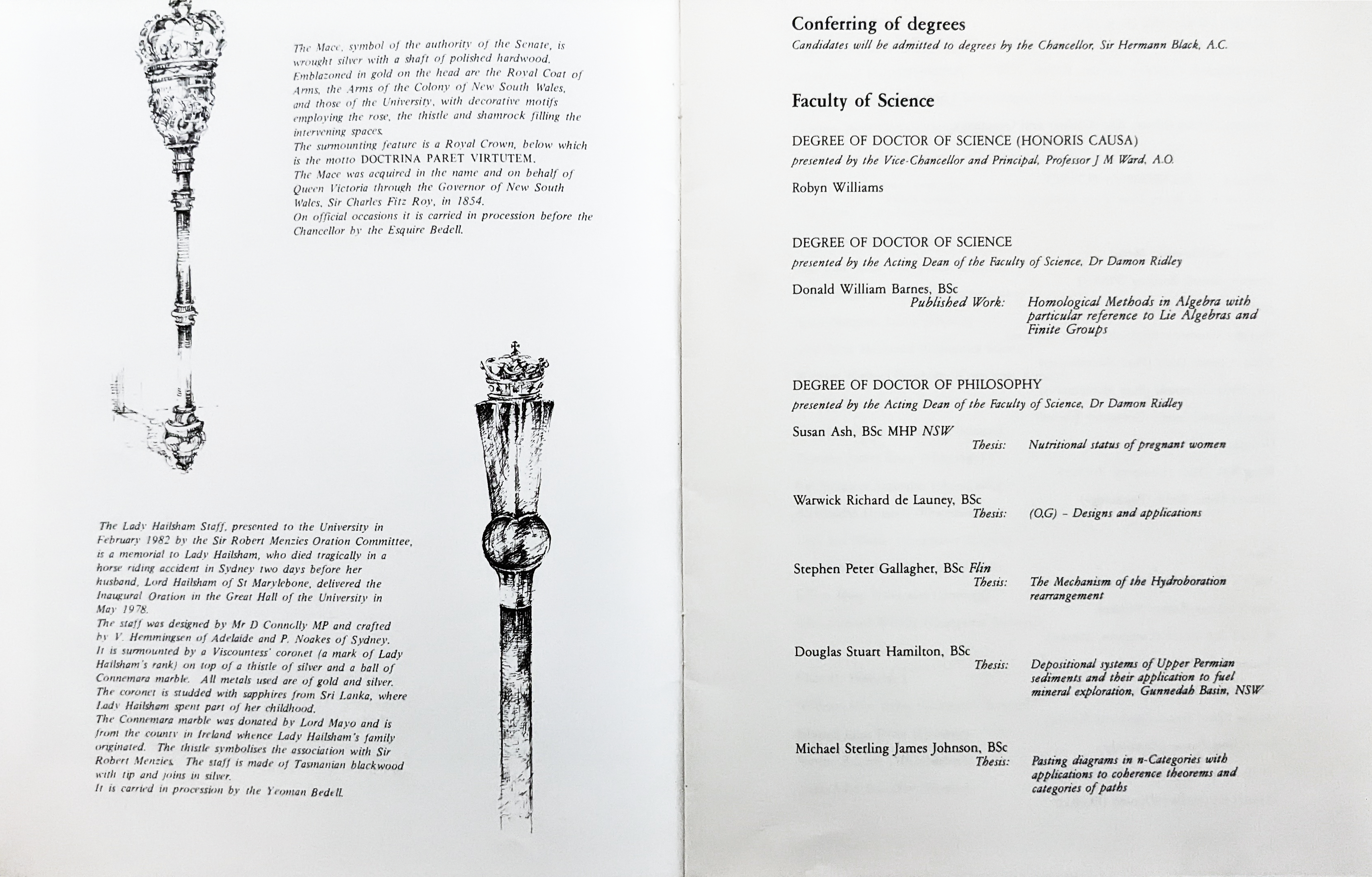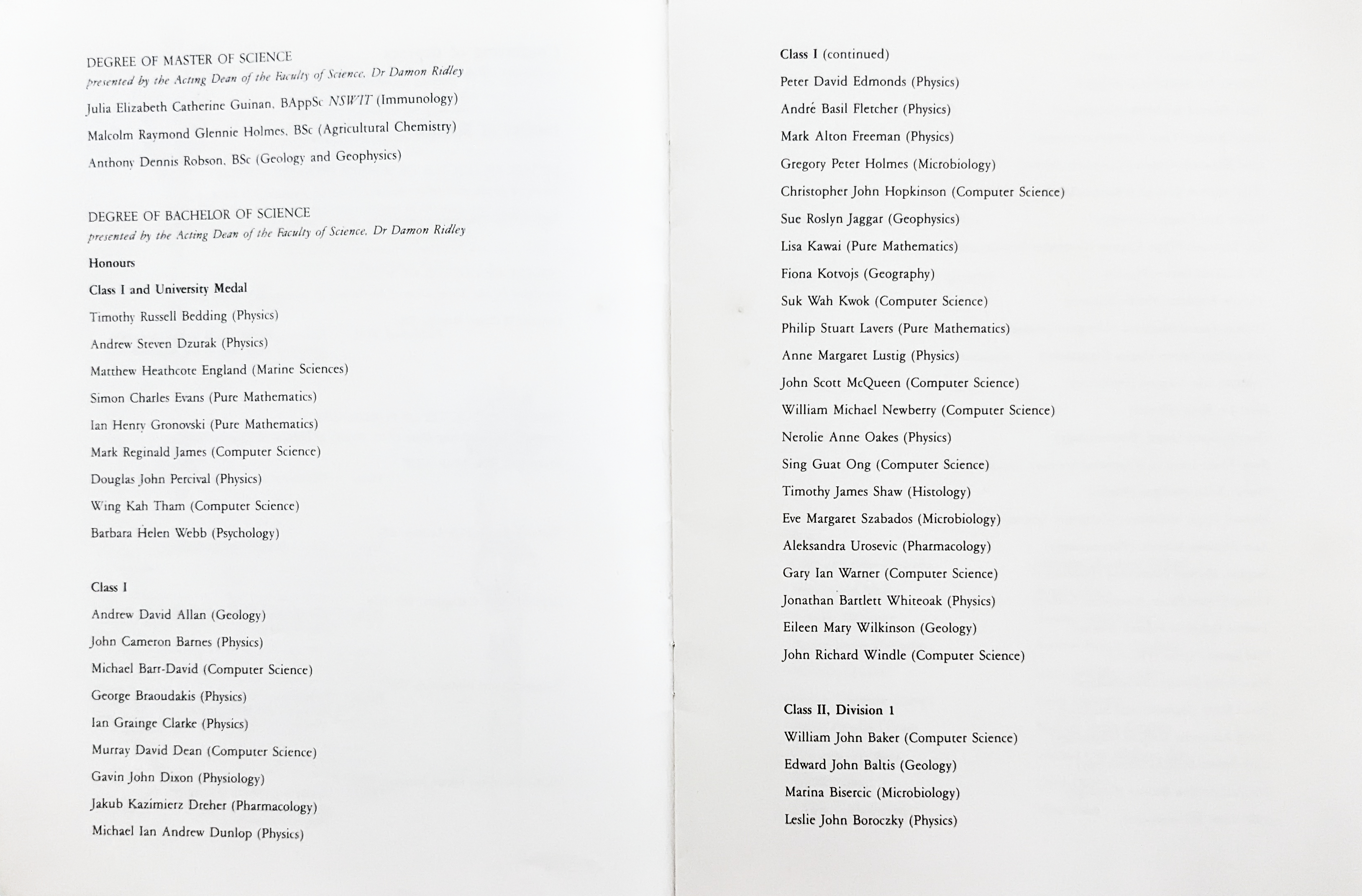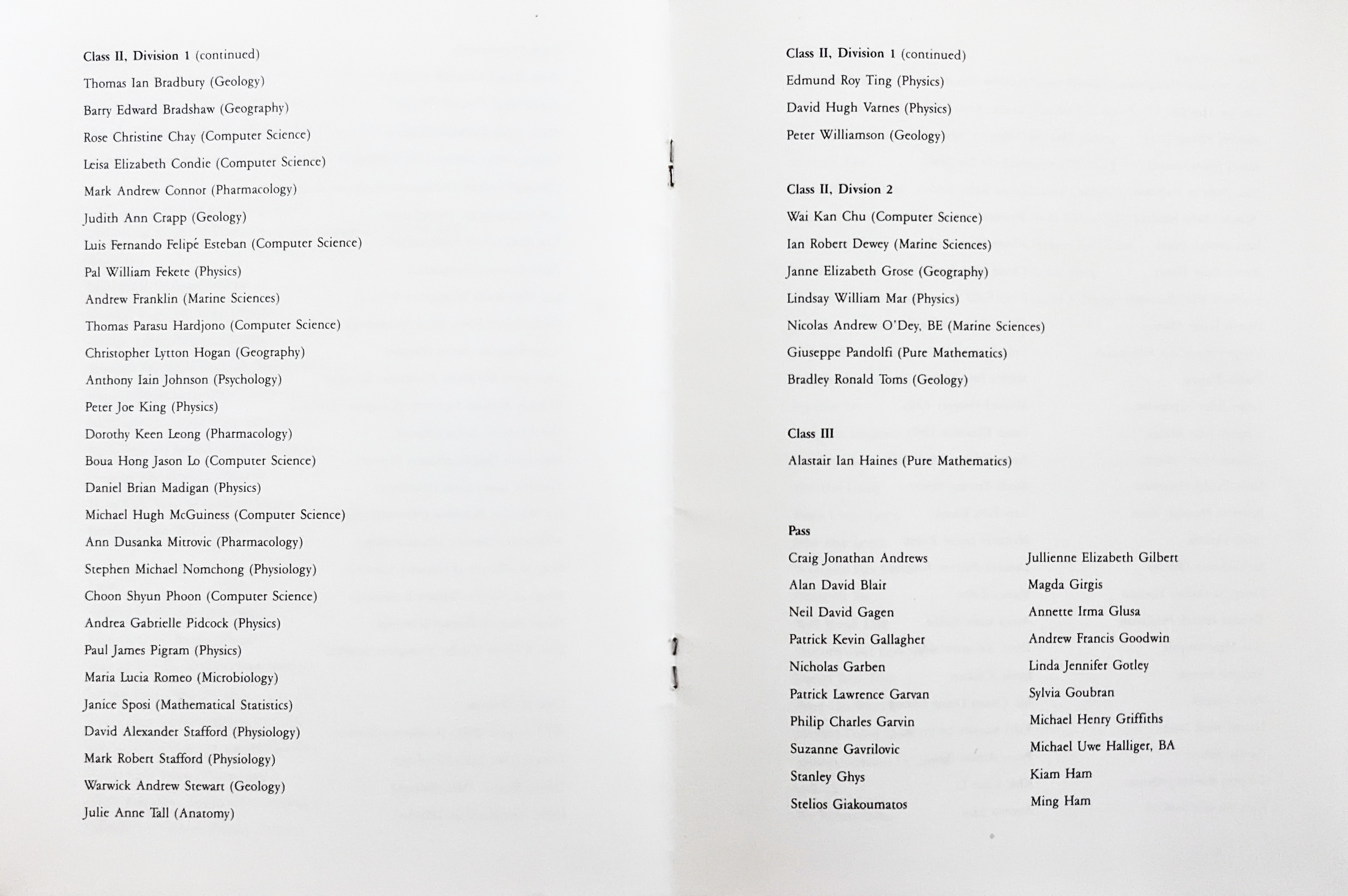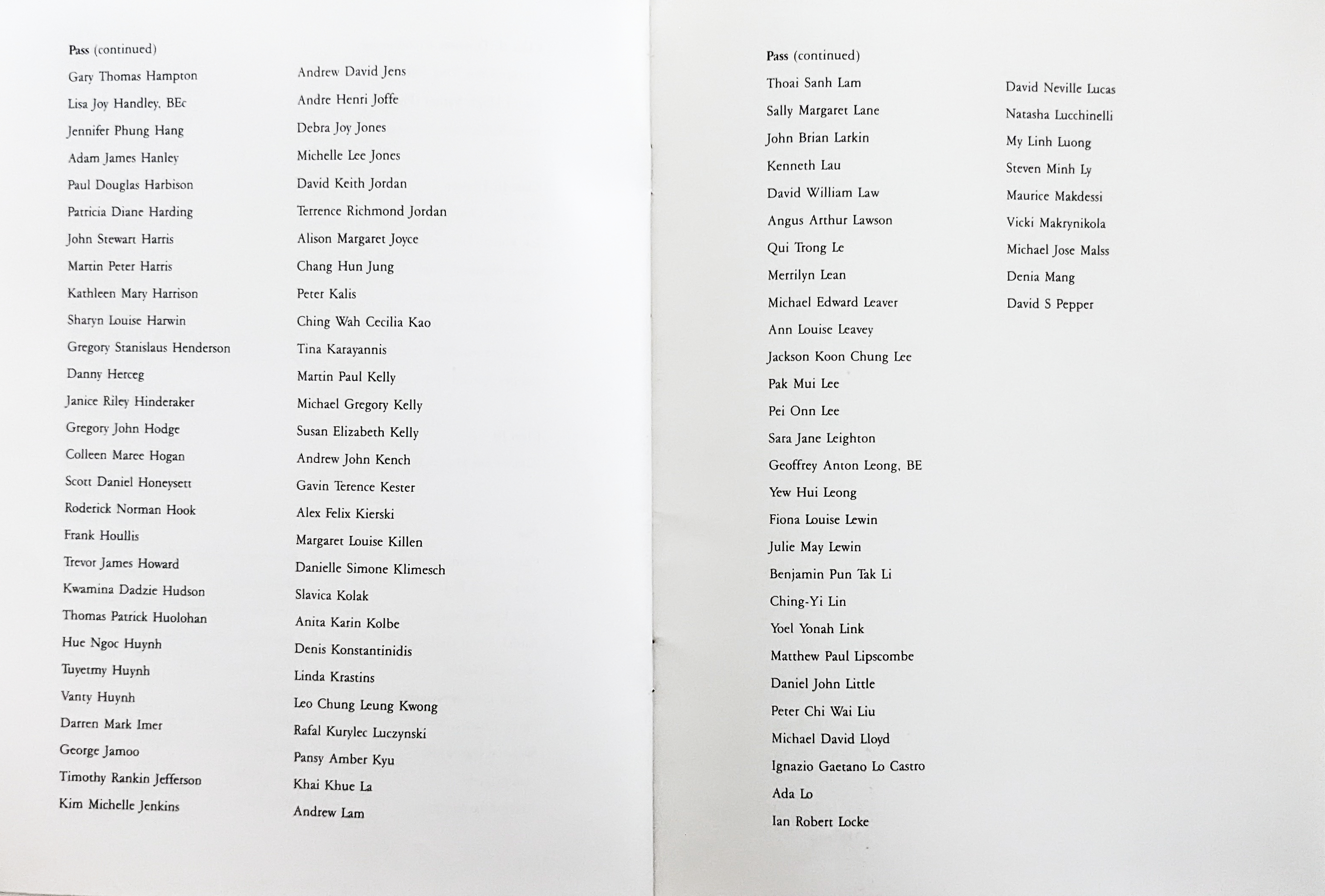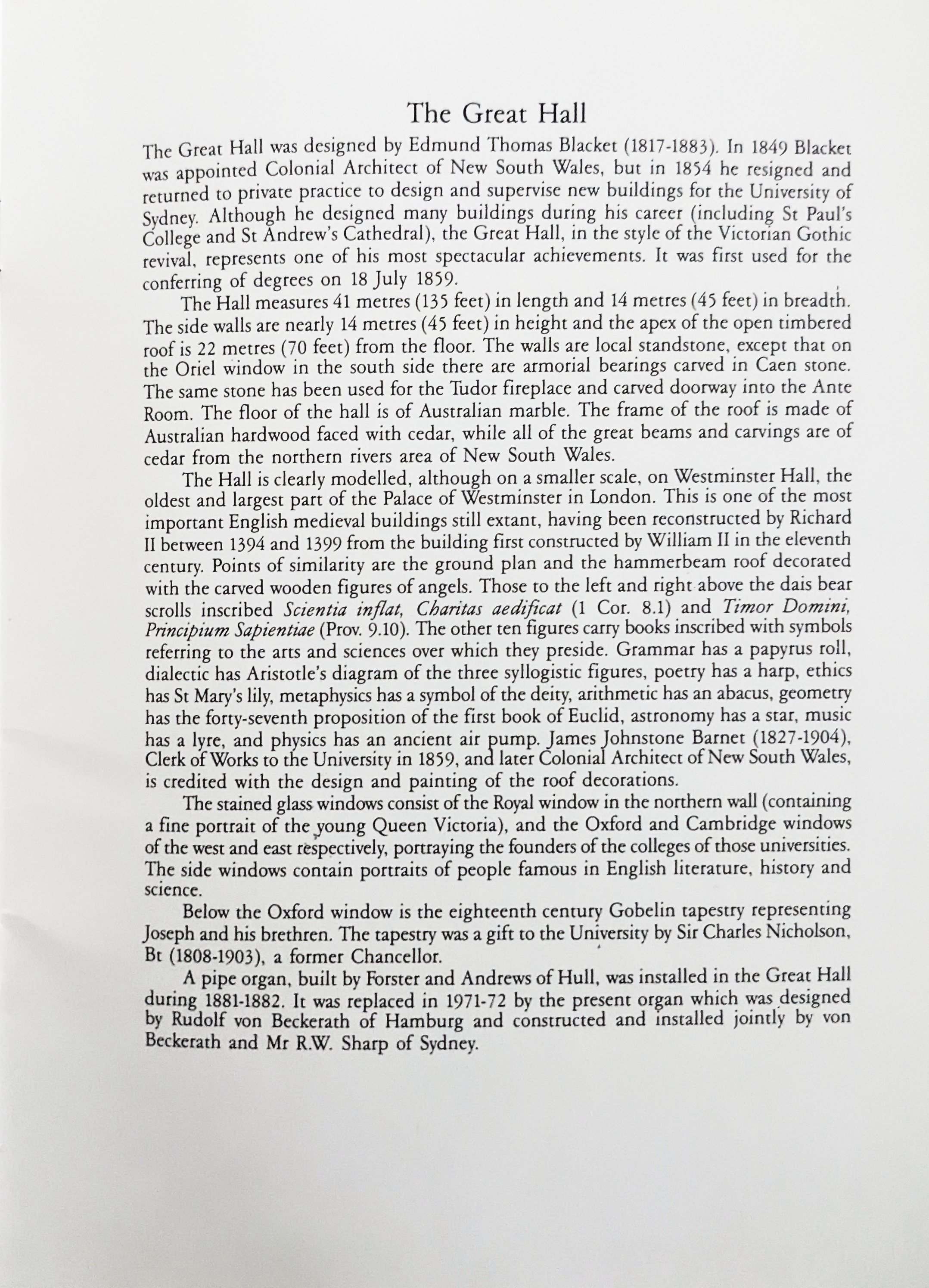Graduation Booklet
by Hugh McGuinness
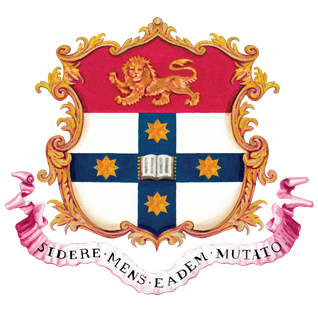
Scan of graduation booklet for Faculty of Science 1988
The University of Sydney
Ceremony of CONFERRING OF DEGREES
The Great Hall
Wednesday 25 May 1988 at 9.30 am
The Chancellor, Sir Hermann Black, A.C., presiding

Order of proceedings
Organ recital
by
the University Organist, Mr Norman Johnston
The academic procession enters the Great Hall,
the assembly standing.
Processional: Fanfare '77 (Platt)
The proceedings are opened by the Chancellor,
Sir Hermann Black, A.C.
Conferring of degrees
The Chancellor welcomes the graduates and visitors.
The occasional address delivered by
Professor R D Guthrie
Vice-Chancellor, University of Technology, Sydney
The academic procession retires, the assembly standing.
Organ Music: 1st Movement from Concerto in F major (Handel).
Carillon recital
by
the University Carillonist, Mr John Gordon

The Mace, symbol of the authority of the Senate, is wrought silver with a shaft of polished hardwood. Emblazoned in gold on the head are the Roval Coat of Arms, the arms of the Colony of New South Wales and those of the University, with decorative motifs employing the rose, the thistle and shamrock filling the intervening spaces.
The surmounting feature is a Royal Crown, below which is the motto DOCTRINA PARET VIRTUTEM. The Mace was acquired in the name and on behalf of Queen Victoria through the Governor of New South Wales. Sir Charles Fitz Roy, in 1834.
On official occasions it is carried in procession before the Chancellor by the Esquire Bedell.

The Lady Hailsham Staff, presented to the University in February 1982 by the Sir Robert Menzies Oration Committee, is a memorial to Lady Hailsham, who died tragically in a horse riding accident in Sydney two days before her husband, Lord Hailsham of St Marylebone, delivered the Inaugural Oration in the Great Hall of the University in May 1978.
The staff was designed by Mr D Connelly MP and crafted by V. Hemmingsen of Adelaide and P. Noakes of Sydney It is surmounted by a Viscountess' coronet (a mark of Lady Hailsham's rank) on top of a thistle of silver and a ball of Connemara marble. All metals used are of gold and silver. The coronet is studed with sapphires from Sri Lanka, where Lady Hailsham spent part of her childhood.
The Connemara marble was donated by Lord Mayo and is from the county in Ireland whence lady Hailsham's family originated. The thistle symbolises the association with Sir Robert Menzies. The staff is made of Tasmanian blackwood with tip and joins in silver.
It is carried in procession by the Yeoman Bedell.
Conferring of degrees
Candidates will be admitted to degrees by the Chancellor. Sir Herman Black, A.C.
Faculty of Science
DEGREE OF DOCTOR OF SCIENCE (HONORIS CAUSA)
presented by the Vice-Chancellor and Principal, Professor I M Ward, A.O.
- Robyn Williams
DEGREE OF DOCTOR OF SCIENCE
presented by the Acting Dean of the Faculty of Science, Dr Damon Ridley
- Donald William Barnes, BSc
Published Work: Homological Methods in Algebra with particular reference to Lie Algebras and Finite Groups
DEGREE OF DOCTOR OF PHILOSOPHY
presented by the Acting Dean of the Faculty of Science, Dr Damon Ridley
- Susan Ash. BSc MHP NSW
Thesis: Nutritional status of pregnant women
- Warwick Richard de Launey, BSc
Thesis: (O.G) - Designs and applications
- Stephen Peter Gallagher. BSc Flin
Thesis: The Mechanism of the Hydroboration rearrangement
- Douglas Stuart Hamilton, BSc
Thesis: Depositional systems of Upper Permian sediments and their abplicatton to fuel mineral exploration, Gunnedah Basin, NSW
- Michael Sterling James Johnson, BSc
Thesis: Pasting diagrams in n-Categories with abblications to coherence theorems and categories of paths
DEGREE OF MASTER OF SCIENCE
presented by the Acting Dean of the Faculty of Science, Dr Damon Ridley
- Julia Elizabeth Catherine Guinan. BAppSc NSIT7 (Immunology)
- Malcolm Raymond Glennie Holmes, Bc (Agricultural Chemistry)
- Anthony Dennis Robson, BSc (Geology and Geophysics)
DEGREE OF BACHELOR OF SCIENCE
presented by the Acting Dean of the faculty of Science, Dr Damon Ridley
Honours
Class I and University Medal
- Timothy Russell Bedding (Physics)
- Andrew Steven Dzurak (Physics)
- Matthew Heathcote England (Marine Sciences)
- Simon Charles Evans (Pure Mathematics)
- Ian Henry Gronovski (Pure Mathematics)
- Mark Reginald James (Computer Science)
- Douglas John Percival (Physics)
- Chris Wing Kah Tham (Computer Science)
- Barbara Helen Webb (Psychology)
Class I
- Andrew David Allan (Geology)
- John Cameron Barnes (Physics)
- Michael Barr-David (Computer Science)
- George Braoudakis (Physics)
- lan Grange Clarke (Physics)
- Murray David Dean (Computer Science)
- Gavin John Dixon (Physiology)
- Jakub Kazimierz Drener (Pharmacology)
- Michael Ian Andrew Dunlop (Physics)
- Peter David Edmonds (Physics)
- André Basil Fletcher (Physics)
- Mark Alton Freeman (Physics)
- Gregory Peter Holmes (Microbiology)
- Christopher John Hopkinson (Computer Science)
- Sue Roslyn Jaggar (Geophysics)
- Lisa Kawai (Pure Mathematics)
- Fiona Kotvojs (Geography)
- Suk Wah Kwok (Computer Science)
- Philip Stuart Lavers (Pure Mathematics)
- Anne Margaret Lustig (Physics)
- John Scott McQueen (Computer Science)
- William Michael Newberry (Computer Science)
- Nerolie Anne Oakes (Physics)
- Sing Guat Ong (Computer Science)
- Timothy James Shaw (Histology)
- Eve Margaret Szabados (Microbiology)
- Aleksandra Urosevic (Pharmacology)
- Gary Ian Warner (Computer Science)
- Jonathan Bartlett Whiteoak (Physics)
- Eileen Mary Wilkinson (Geology)
- John Richard Windle (Computer Science)
Class II, Division 1
- William John Baker (Computer Science)
- Edward John Baltis (Geology)
- Marina Bisercic (Microbiology)
- Leslie John Boroczky (Physics)
- Thomas Ian Bradbury (Geology)
- Barry Edward Bradshaw (Geography)
- Rose Christine Chay (Computer Science)
- Leisa Elizabeth Condie (Computer Science)
- Mark Andrew Connor (Pharmacology)
- Judith Ann Crapp (Geology)
- Luis Fernando Felipé Esteban (Computer Science)
- Pal William Fekete (Physics)
- Andrew Franklin (Marine Sciences)
- Thomas Parasu Hardjono (Computer Science)
- Christopher Lytton Hogan (Geography)
- Anthony Iain Johnson (Psychology)
- Peter Joe King (Physics)
- Dorothy Keen Leong (Pharmacology)
- Boua Hong Jason Lo (Computer Science)
- Daniel Brian Madigan (Physics)
- Michael Hugh McGuinness (Computer Science)
- Ann Dusanka Mirrovic (Pharmacology)
- Stephen Michael Nomchong (Physiology)
- Choon Shyun Phoon (Computer Science)
- Andrea Gabrielle Pidcock (Physics)
- Paul James Pigram (Physics)
- Maria Lucia Romeo (Microbiology)
- Janice Sposi (Mathematical Statistics)
- David Alexander Stafford (Physiology)
- Mark Robert Stafford (Physiology)
- Warwick Andrew Stewart (Geology)
- Julie Anne Tall (Anatomy)
- Edmund Roy Ting (Physics)
- David Hugh Varnes (Physics)
- Peter Williamson (Geology)
Class II, Division 2
- Wai Kan Chu (Computer Science)
- Ian Robert Dewey (Marine Sciences)
- Janne Elizabeth Grose (Geography)
- Lindsay William Mar (Physics)
- Nicolas Andrew O’Dey, BE (Marine Sciences)
- Giuseppe Pandolfi (Pure Mathematics)
- Bradley Ronald Toms (Geology)
Class III
- Alastair Ian Haines (Pure Mathematics)
Pass
- Craig Jonathan Andrews
- Alan David Blair
- Neil David Gagen
- Patrick Kevin Gallagher
- Nicholas Garben
- Patrick Lawrence Garvan
- Philip Charles Garvin
- Suzanne Gavrilovic
- Stanley Ghys
- Stelios Giakoumatos
- Julienne Elizabeth Gilbert
- Magda Girgis
- Annerte Irma Glusa
- Andrew Francis Goodwin
- Linda Jennifer Gotley
- Sylvia Goubran
- Michael Henry Griffiths
- Michael Uwe Halliger, BA
- Kiam Ham
- Ming Ham
- Gary Thomas Hampton
- Lisa Joy Handley, BEc
- Jennifer Phung Hang
- Adam James Hanley
- Paul Douglas Harbison
- Patricia Diane Harding
- John Stewart Harris
- Martin Peter Harris
- Kathleen Mary Harrison
- Sharyn Louise Marwin
- Gregory Stanislaus Henderson
- Danny Herceg
- Janice Riley Hinderaker
- Gregory John Hodge
- Colleen Maree Hogan
- Scot Daniel Honeysett
- Roderick Norman Hook
- Frank Houllis
- Trevor James Howard
- Kwamina Dadzie Hudson
- Thomas Patrick Huolohan
- Hue Ngoc Huynh
- Tuyermy Huynh
- Vanty Huynh
- Darren Mark Imer
- George Jamoo
- Timothy Rankin Jefferson
- Kim Michelle Jenkins
- Andrew David Jens
- Andre Henri Joffe
- Debra Joy Jones
- Michelle Lee Jones
- David Keith Jordan
- Terrence Richmond Jordan
- Alison Margaret Joyce
- Chang Hun Jung
- Perer Kalis
- Ching Wah Cecilia Kao
- Tina Karayannis
- Martin Paul Kelly
- Michael Gregory Kelly
- Susan Elizabeth Kelly
- Andrew John Kench
- Gavin Terence Kester
- Alex Felix Kierski
- Margaret Louise Killen
- Danielle Simone Klimesch
- Slavica Kolak
- Anita Karin Kolbe
- Denis Konstantinidis
- Linda Krastins
- Leo Chung Leung Kwong
- Rafal Kurylec Luczynski
- Pansy Amber Kyu
- Khai Khue La
- Andrew Lam
- Thoai Sanh Lam
- Sally Margaret Lane
- John Brian Larkin
- Kenneth Lau
- David William Law
- Angus Arthur Lawson
- Qui Trong Le
- Merrilyn Lean
- Michael Edward Leaver
- Ann Louise Leavey
- Jackson Koon Chung Lee
- Pak Mui lee
- Pei Onn Lee
- Sara Jane Leighton
- Geoffrey Anton Leong, BE
- Yew Hui Leong
- Fiona Louise Lewin
- Julie May Lewin
- Benjamin Pun Tak Li
- Ching-Yi Lin
- Yoel Yonah Link
- Matthew Paul Lipscombe
- Daniel John Little
- Peter Chi Wai Liu
- Michael David Lloyd
- Ignazio Gaetano lo Castro
- Ada Lo
- Jan Robert locke
- David Neville Lucas
- Natasha Lucchinelli
- My Linh Luong
- Steven Minh Ly
- Maurice Makdessi
- Vicki Makrynikola
- Michael Jose Malss
- Denia Mang
- David S Pepper
The Great Hall
The Great Hall was designed by Edmund Thomas Blacket (1817-1883). In 1849 Blacket was appointed Colonial Architect of New South Wales, but in 1854 he resigned and returned to private practice to design and supervise new buildings for the University of Sydney. Although he designed many buildings during his career (including St Paul’s College and St Andrew’s Cathedral), the Great Hall, in the style of the Victorian Gothic revival, represents one of his most spectacular achievements. It was first used for the conferring of degrees on 18 July 1859.
The Hall measures 41 metres (135 feet) in length and 14 metres (45 feet) in breadth. The side walls are nearly 14 metres (45 feet) in height and the apex of the open timbered roof is 22 metres (70 feet) from the floor. The walls are local standstone, except that on the Oriel window in the south side there are armorial bearings carved in Caen stone. The same stone has been used for the Tudor fireplace and carved doorway into the Ante Room. The floor of the hall is of Australian marble. The frame of the roof is made of Australian hardwood faced with cedar, while all of the great beams and carvings are of cedar from the northern rivers area of New South Wales.
The Hall is clearly modelled, although on a smaller scale, on Westminster Hall, the oldest and largest part of the Palace of Westminster in London. This is one of the most important English medieval buildings still extant, having been reconstructed by Richard II between 1394 and 1399 from the building first constructed by William II in the eleventh century. Points of similarity are the ground plan and the hammerbeam roof decorated with the carved wooden figures of angels. Those to the left and right above the dais bear scrolls inscribed Scientia inflat, Charitas aedificat (1 Cor. 8.1) and Timor Domini, Principium Sapientiae (Prov. 9.10). The other ten figures carry books inscribed with symbols referring to the arts and sciences over which they preside. Grammar has a papyrus roll, dialectic has Aristotle’s diagram of the three syllogistic figures, poetry has a harp, ethics has St Mary’s lily, metaphysics has a symbol of the deity, arithmetic has an abacus, geometry has the forty-seventh proposition of the first book of Euclid, astronomy has a star, music is credited with the design and painting of the roof decorations.
The stained glass windows consist of the Royal window in the northern wall (containing a fine portrait of the young Queen Victoria), and the Oxford and Cambridge windows of the west and east respectively, portraying the founders of the colleges of those universities. The side windows contain portraits of people famous in English literature, history and science.
Below the Oxford window is the eighteenth century Gobelin tapestry representing Joseph and his brethren. The tapestry was a gift to the University by Sir Charles Nicholson, Bt (1808-1903), a former Chancellor.
A pipe organ, built by Forster and Andrews of Hull, was installed in the Great Hall during 1881-1882. It was replaced in 1971-72 by the present organ which was designed by Rudolf von Beckerath of Hamburg and constructed and installed jointly by von Beckerath and Mr R.W. Sharp of Sydney.
